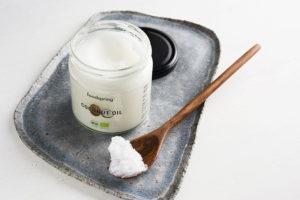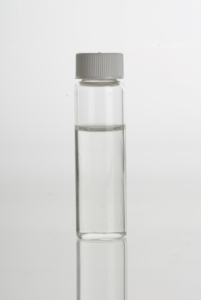With a headline asking “Is Fluoride the New Mercury?” how could you not go see what it has to say, even if it’s on a site you never, ever visit – in this case, Vogue?
Is fluoride the new mercury? Neither belongs in the human body. Both are neurotoxins.
But that’s not what the article was about, and it’s not what made it interesting. Under the headline was a slideshow of “natural toothpaste alternatives,” which included, weirdly, a lot of mouthwashes – and mouthwash just can’t do the job that brushing and flossing are needed to do.
But that’s not the interesting part either.
No, what caught our attention was one product in particular – an “oil pulling mouthwash.” Instantly, we suspected that this was one of those products trying to piggyback on the popularity of something genuinely healthful, like “organic water,” to use perhaps the most notorious example.
 Oil pulling, as we’ve noted before, is a practice that can really do wonders, especially for periodontal (gum) health and especially when done with coconut oil. And there’s good science backing it up – as well as demonstrating the antimicrobial qualities of coconut oil in particular. Clinically, we see that it works.
Oil pulling, as we’ve noted before, is a practice that can really do wonders, especially for periodontal (gum) health and especially when done with coconut oil. And there’s good science backing it up – as well as demonstrating the antimicrobial qualities of coconut oil in particular. Clinically, we see that it works.
But it’s nothing like using a mouthwash. That’s something you swish around for a few seconds. Oil pulling is something you do for 15 minutes or so.
Mouthwash is largely about freshening breath. Oil pulling is about pulling out and spitting out oral pathogens and other toxins.
And mouthwash is liquid. Coconut oil is solid at room temperature (well, maybe not in Texas on a summer day, but you get the idea). And the product we saw in that slideshow looked really liquidy.
So we hopped on over to the product website to see what’s actually in it.
First item in the ingredient list? Sesame oil. Liquid. Okay. That’s one of the traditional oil pulling oils.
 Then comes “MCT oil (fractionated coconut oil).” MCT stands for medium chain triglycerides, or fatty acids. It’s part of coconut oil – a fraction – but not the whole oil. In fact, one of the most important compounds in coconut oil is precisely what gets fractioned out – the lauric acid.
Then comes “MCT oil (fractionated coconut oil).” MCT stands for medium chain triglycerides, or fatty acids. It’s part of coconut oil – a fraction – but not the whole oil. In fact, one of the most important compounds in coconut oil is precisely what gets fractioned out – the lauric acid.
Take that out, and the oil will remain liquid at room temperature. But you also take out what makes coconut oil so effective. It’s the source of its antimicrobial properties.
Interestingly, we found other “oil pulling mouthwashes” – such as this one – which emphasize Capric-Caprylic acid in the ingredients list. Well, that’s nice, and Capric acid may have some antimicrobial qualities, as well. Still, it seems to indicate a fractionated oil – one missing that important lauric acid.
And these products are expensive, too – $5 per ounce expensive, or $40 for an 8 ounce bottle! You can get a16 ounce jar of good quality extra virgin coconut oil, on the other hand, for about $10 or less.
And you get coconut oil’s full power, too.
Learn more about coconut oil:
- Is Liquid Coconut Oil that stays Liquid in Your Refrigerator Real Coconut Oil?
- What Kind of Coconut Oil Is Best? How to Choose a Coconut Oil
Coconut oil in spoon image by Paul Reis123, via Wikimedia Commons